geforce
Latest

NVIDIA kills its 'anticompetitive' GeForce Partner Program
NVIDIA has canceled the GeForce Partner Program (GPP) just two months after announcing it. The GPP began with little fanfare in early March, but it quickly became clear (thanks to work by HardOCP's Kyle Bennett) that it was more than a simple branding initiative. Bennett showed that GPP was encouraging manufacturers to solely produce PCs and laptops with NVIDIA GPUs inside. Manufacturers could still opt for AMD cards, but they would have to be sold through a different brand. Should a manufacturer not play ball, NVIDIA would at best not include it in marketing efforts, and at worst actively hold back inventory to exclude it from upcoming GPU launches.
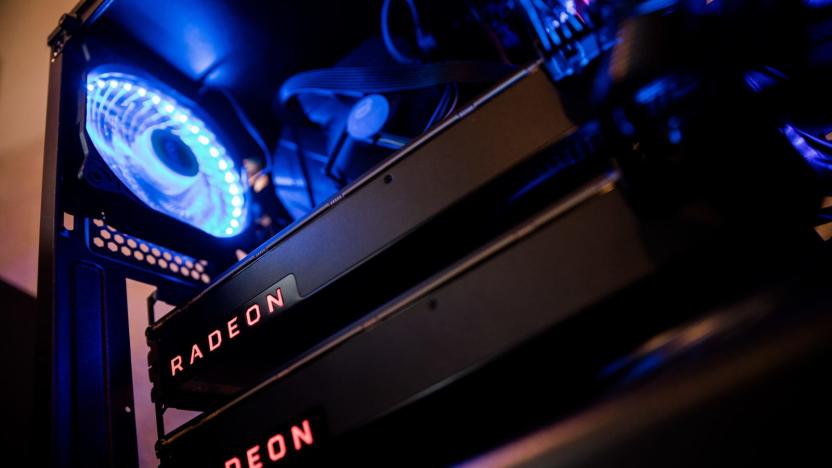
AMD calls out NVIDIA's partner program, G-Sync 'gamer taxes'
A promotional push by NVIDIA has apparently tied up PC builders, and raised the ire of its competitor AMD. The current leader in the graphics card market, NVIDIA has apparently developed a GeForce Partner Program (GPP) that it claims exists to "ensure that gamers have full transparency into the GPU platform and software they're being sold, and can confidently select products that carry the NVIDIA GeForce promise." But according to AMD, that vague explanation hides an attempt to elbow competition out of high-profile system lines. A recent report by HardOCP suggests that for PC builders to be a part of the program (with access to combined marketing efforts, bundles and rebate offers) they have to exclusively align their gaming brand with NVIDIA's GeForce hardware (and not AMD's Radeon). Things came to a head yesterday when ASUS suddenly announced a new gaming line, AREZ, that apparently exists only to keep AMD Radeon-powered PCs out of its well-known ROG gaming equipment. With AMD out of the way, the ROG line can join NVIDIA's GPP.
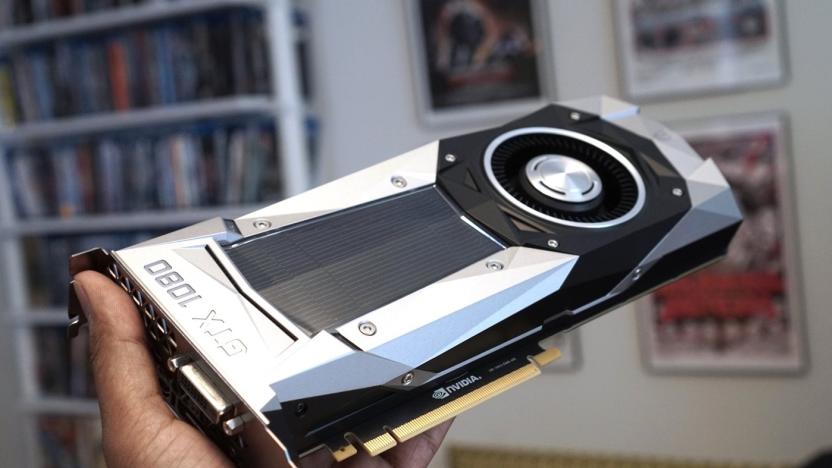
NVIDIA updates video drivers to help address CPU memory security (updated)
It's not just your processor and operating system that need patches for the Meltdown and Spectre memory vulnerabilities -- your graphics card does, too. To that end, NVIDIA has started releasing updated drivers that help protect against the CPU vulnerability. All its GeForce, Quadro, NVS, Tesla and GRID chips are immune to Meltdown and Spectre themselves, but the code could leave CPUs open to two Spectre variants. The new software immediately mitigates one Spectre flaw, and NVIDIA is promising future mitigations as well as eventual updates to address the second.

Gigabyte made the tiniest GeForce GTX 1080 card yet
NVIDIA has been shrinking gaming laptops with its Max-Q graphics initiative, but what about desktop users who want high-end graphics in a discreet, portable case? Gigabyte has come up with the GeForce GTX 1080 Mini ITX 8G, an unwieldy name for the world's smallest GTX 1080 graphics card. At just 16.9 cm (6.7 inches), it's nearly four inches shorter than a regular model, so it can be tucked into a Mini-ITX case (6.7 x 6.7 inches), as the name implies. Yet, it packs the same power as any other GTX 1080 desktop card, letting you do 4K video, gaming and VR with ease.

NVIDIA 'Max-Q' gaming laptops are Ultrabooks with GTX 1080 power
Based on NVIDIA's 2017 Computex announcements, PC gamers won't have to choose between bulky gaming laptops and desktop-level processing power for much longer. A new design called "Max-Q" is arriving in laptops that it claims are both three times thinner and three times more powerful than their predecessors. Think: 18mm thick, 5 pounds and with the power of NVIDIA's GTX 1080 inside. Plus, there's "WhisperMode," which can pace the game's frame rate to keep the laptop cool and quiet during a plugged-in gaming session.
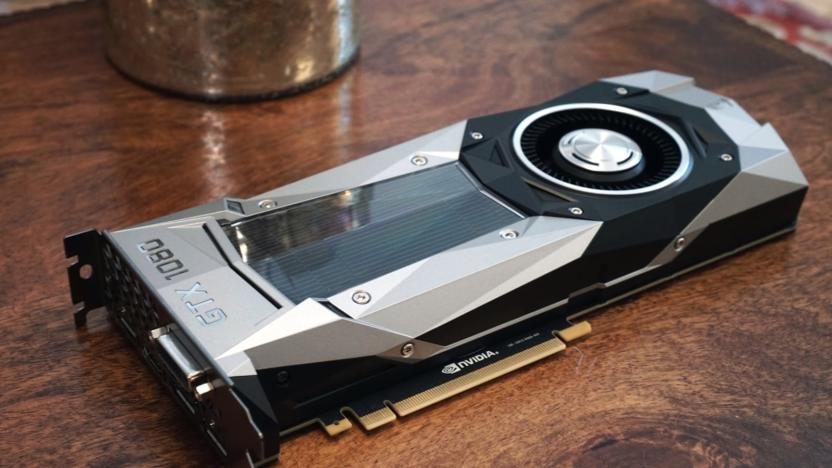
NVIDIA posts Mac drivers for its latest graphics cards
NVIDIA is quickly making good on its promise to support its latest graphics cards on Macs. The GPU giant has quietly posted beta macOS drivers (direct download) that should support any GeForce 10-series card, whether it's a simple GTX 1050 or an all-out beast like the Titan Xp. It's a big step forward for Mac users who've had to settle for 9-series cards at best. However, the big challenge will be making the most of the cards given the current Mac lineup -- this is as much an investment in the future as anything.

NVIDIA reveals its $700 top-of-the-line GTX 1080 Ti
Last year we called NVIDIA's GeForce GTX 1080 "the upgrade you've been waiting for," and now PC gamers have another high-end graphics card to drool over. At GDC 2017, CEO Jen-Hsun Huang presented its successor, the GTX 1080 Ti, which promises "35 percent more performance," packs 11GB of GDDR5X memory and will go on sale March 10th for $700. In fact, NVIDIA even claims this new card is faster than its $1,200 Titan X that launched late last year for professionals. At the same time, the company announced the 1080 is getting a price cut and will now start at $500.

NVIDIA brings GeForce Now cloud gaming to Mac and PC
Ever wanted to be a PC gamer, but didn't want to buy a gaming PC? NVIDIA's Jen-Hsun Haung wants your number. Taking the stage at CES today, the CEO announced GeForce Now for Mac and PC -- an offshoot of its cloud gaming service aimed at prospective PC gamers. Despite sharing the same name as the streaming service, it offers to NVIDIA Shield users, GeForce Now for Mac and PC isn't a gaming-subscription service. It's a server rental program.
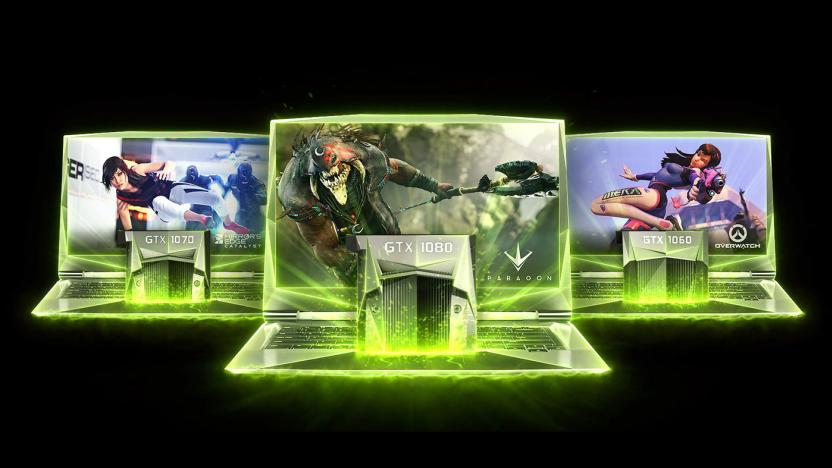
NVIDIA brings desktop-class graphics to laptops
With the GeForce GTX 1080, NVIDIA pushed the boundaries of what a $600 graphics card can do. That flagship card was joined by the GTX 1070 and GTX 1060, two lower-power cards based on the same 16nm Pascal architecture at a much more affordable price. Now, it's bringing mobile versions of those cards that match their desktop counterparts in almost every area -- including being VR ready. That's not hyperbole. The top-of-the-line laptop 1080 has 2,560 CUDA cores and 8GB of 10Gbps GDDR5x memory. The desktop chip has the same. The only difference is clock speed: it's set at 1,556MHz, while the desktop version is 1,607MHz. The two do share the same boost clock (1,733MHz) though, and both have access to all the new technology introduced for the Pascal architecture. That means simultaneous multi-projection, VRWorks, Ansel and the rest.

Thin gaming laptops will run VR with NVIDIA's new chip
Nvidia has just taken the wraps off a trio of laptop GPUs based on its new "Pascal" chip architecture, the GeForce GTX 1060, the 1070 and the 1080. While the 1080 is by far the most impressive, it's the humble 1060 that could make the biggest impact on the market. Why? Because it facilitates using a virtual reality headset like the HTC Vive or the Oculus Rift on a reasonably small laptop.

NVIDIA's GeForce GTX 1060 gives you gaming power on a budget
After debuting the fastest high-end and mid-range video cards ever seen, the GTX 1080 and 1070, we expected a lot from NVIDIA's new lower-tier entry, the $249 GeForce GTX 1060. And the stakes were raised even higher after AMD launched the Radeon RX 480, a $200 GPU that's fast enough to power VR headsets (and manage some decent 1440p gaming). NVIDIA claims the GTX 1060 is even faster than the GTX 980, its premium video card from 2014. That says quite a bit about how far we've come in the GPU world: You no longer have to break the bank for a decent amount of gaming muscle.

NVIDIA's 'VR Funhouse' carnival game just launched on Steam
A few months ago, NVIDIA showed off a new virtual reality tech demo designed to showcase what its new graphics technology could do for VR. Today, it's releasing that demo to the public: VR Funhouse is a free, virtual reality carnival with collision-based haptic feedback, advanced physics simulation and a ton of other NVIDIA graphics technologies designed to make fire, hair, water and particles all look more real. All you need to play is an HTC Vive and a really, really powerful computer.

NVIDIA's GTX 1080 GPU is faster than Titan X, lands May 27
NVIDIA gave us a taste of its new Pascal architecture with the P100 graphics card last month, which is aimed at servers for heavy duty computing. Now, it's ready to show off how that technology will be adapted for consumers with its new GeForce GTX 1080 GPU. As you'd expect, it's fast: NVIDIA CEO Jen-Hsun Huang revealed that it's faster than its current performance king, the $1,000 Titan X, as well as three times as power efficient. That's particularly impressive since it's the successor to NVIDIA's GTX 980, which retails for around $600.
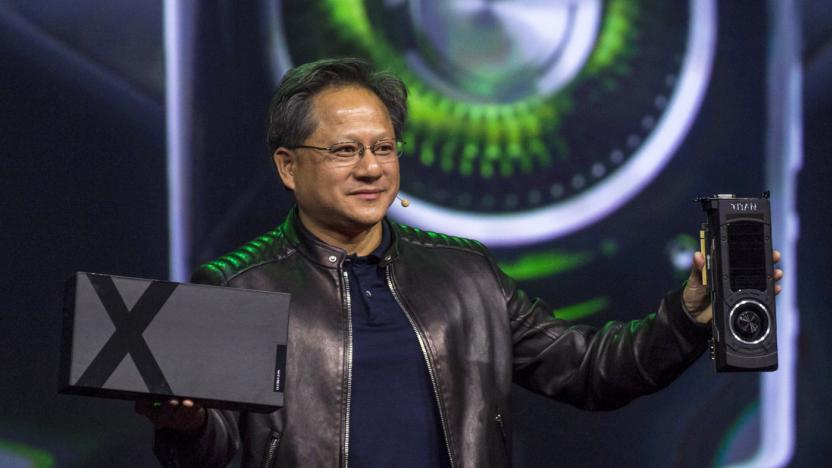
Glitchy NVIDIA graphics driver cooks graphics cards (update: not that bad)
Many gamers will tell you to hold off on installing the latest drivers for your video card until you know they're safe... and here's why. NVIDIA has pulled a GeForce driver (364.47) after numerous reports of problems with the installation. The symptoms vary from freezing and visual glitches to serious crises like failures to boot or, supposedly, burnt out cards. That's not fun if it turns your costly Titan X into a paperweight. The exact cause isn't clear, but NVIDIA's early look suggests that choosing the express installation creates the problem. Some fans suggest that it may be due to a conflict between old and new software.
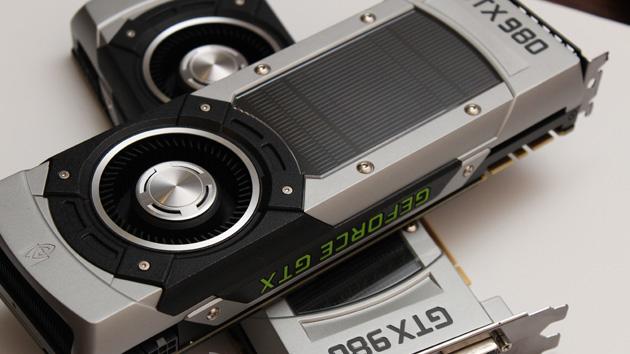
Samsung asks the US government to block NVIDIA's chips
The patent war between NVIDIA and Samsung isn't going to wind down any time soon. Samsung has backed up its countering lawsuit against NVIDIA with a US International Trade Commission complaint asking the agency to block imports of NVIDIA's GeForce graphics chips and Tegra mobile processors. While it's not clear just which parts are under scrutiny, the dispute names a slew of third-party device makers who'd have to stop selling hardware in the US. Most of them are video card designers, such as Biostar and EVGA, but the action would also affect Tegra-based gadgets like OUYA's mini console and the Wikipad gaming tablet.

NVIDIA's latest GPU crams 4K images on 1080p displays
Back in February, NVIDIA trotted out the very first desktop GPUs to feature its new Maxwell architecture: the GeForce GTX 750 and 750i. These entry level cards were paragons of efficiency, but they were hardly strong examples of what the company's latest graphics technology was truly capable of. No, NVIDIA revealed those graphics cards today -- the GeForce GTX 980 and 970 desktop GPUs. The new flagship GPUs still benefit from the efficiency gains made by the first generation Maxwell cards, but lean far more heavily on performance. If you're a PC gamer with a GTX 680 or 560 in your tower, these are the cards NVIDIA wants you to upgrade to.

Digital Storm's revamped gaming laptops boast extra-speedy NVIDIA graphics
If you've been waiting for a gaming laptop that wrings the most performance out of NVIDIA's new GeForce 800M graphics chips, you may want to check out Digital Storm's freshly revamped laptop line. The Javelin, Lance, Krypton and Behemoth all carry fast dedicated video, ranging from the GeForce GTX 860M (in everything but the Behemoth) all the way to dual GTX 880M chips in higher-end Krypton and Behemoth models. Beyond that, you're mostly paying for screen size and frills. The Lance starts things off at $1,196 for a 15.6-inch 1080p screen, a quad-core 2.4GHz Core i7, 8GB of RAM and a 750GB hard drive. Step up to the $1,430 Lance and you'll get both improved cooling and audio alongside minor spec bumps; the $1,478 Krypton adds a 17.3-inch screen, while the $2,289 Behemoth takes a big leap forward in speed with a GTX 880M GPU, 16GB of RAM and a 128GB solid-state primary drive. All of Digital Storm's latest portables are available to order today.

Titanfall on PCs will soon support 4K and NVIDIA's latest graphics tricks (updated)
Many gamers already argue that the PC version of Titanfall is the best-looking of the bunch. Pretty soon, though, it won't even be a contest. Respawn plans to update its robotic shooter to handle both 4K displays as well as a host of technology from NVIDIA's GameWorks program, including full support for multiple GeForce cards, improved antialiasing and more realistic shadow effects. The upgrades aren't all that surprising. Some modern video hardware is powerful enough for 4K gaming, and developers have already used GameWorks to spruce up flagship titles like Assassin's Creed 4 and Call of Duty: Ghosts. Still, the visual improvements are bound to make a big impact -- Titanfall is one of the most important games of the year, and a good excuse to pick up a new gaming rig. Update: Right now however, Titanfall is getting some tweaks on its servers that will change how it plays on PC and Xbox One. The updates will roll out over the next day, but you can see a changelog on Respawn's forums here. There are a number of fixes and updates included, and among them it appears the controversial Smart Pistol is having its effectiveness reduced, with slightly lower accuracy from hip fire and decreased damage when it's not locked-on. A troublesome glitch that allowed Burn Cards to be duplicated has also been fixed, and point values for certain actions in Hardpoint and Capture The Flag games have been adjusted.

NVIDIA says most laptops die after 50 minutes of gaming, claims new GPUs will double stamina
Thanks to the appearance of a curiously thin MSI gaming laptop at CeBIT a few days ago, we had an inkling that NVIDIA's new batch of laptop GPUs were inbound. Indeed, the 800M series has just become official, with a number of features geared toward portability and battery life. For a start, the lower half of the stack -- the 830M, 840M, 850M and 860M -- has been endowed with the company's latest Maxwell architecture, which allows gaming credentials to be claimed by thinner and lighter machines. The new Gigabyte P74 is a decent example: It contains an 860M inside a 21mm-thick chassis and we managed to play BioShock Infinite on it, running at 1080p and max settings with a frame rate above 40 fps -- that's a level of performance that NVIDIA says would have required a 55mm-thick laptop three years ago. The other big promise with this generation concerns battery life, and it comes courtesy of a setting called "Battery Boost."

NVIDIA Titan Black cards bring much improved specs, even crazier prices
That's right, a thousand dollars is just the starting price for the new Titan Black, which surpasses and replaces the original $999 GTX Titan that came out last year. Thanks to a more overclock-friendly version of NVIDIA's "Big Kepler" silicon, card vendors are offering custom-cooled versions of the Titan Black that go way beyond the 889MHz reference design, with monetary premiums to match. EVGA looks to be bringing out a 1GHz "HydroCopper" variant, for example, which will likely fetch in the region of $1,100 -- just reasonable enough, in a twisted sort of way, to make you question whether buying a base card might be selling yourself short. But the Titan Black is about more than just clock speeds. It adopts the gaming-focused features of the $699 GTX 780 Ti, including a full quota of 2,880 stream processors and 240 texture units, and it combines them with the 6GB of GDDR5 and double precision floating point performance that made the first Titan so good at semi-professional GPU compute tasks (just below the level of a Tesla). We haven't seen many reviews yet, aside from one saucy piece of literature that looked at four Titan Blacks side-by-side in SLI mode, but it looks like NVIDA might have finally hit on a solid product for those of us who want to mix business with pleasure.






